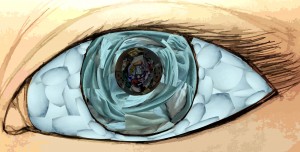After doing my written observation and analysis of the process of waking up, I could not stop thinking about that first instant I am awoken by my alarm and jerked out of the dream or peaceful sleep that I was in. As you lay there, the dream and place you were once in begins to fade at a rapid speed and a few seconds later you can barely remember what happened in it, and you only have a haze of where your mind just was as your eyes readjust to the light and the room around you. This all happens in such a small amount of time, yet it is a lot for you to visually process. After reading Speed: Aberrations of Time and Movement by Oliver Sacks, I was struck by this small time span once again. Sacks states, “Dreams can take wing, move freely and swiftly, precisely because the activity of the cerebral cortex is not constrained by external perception or reality.” When we are dreaming, our minds can churn out stories and thoughts in a matter of milliseconds, whereas while we are awake, our perception of time slows down significantly. This was all my inspiration behind my project. I wanted to capture how through the eye, in that time span, your dreams become smaller and harder to see while your surroundings become more apparent as time becomes slower and larger.
